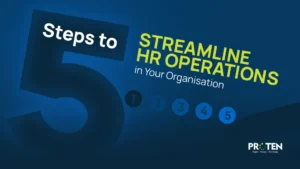Offboarding is often viewed as the final chapter in an employee’s journey with a company. It can be a bittersweet moment, marking the end of one professional relationship and the beginning of another. However, a well-executed offboarding process can leave a lasting positive impression, ensuring that departing employees feel valued and appreciated.
As an HR manager, you play a crucial role in ensuring a smooth and efficient offboarding experience. By following a structured process, you can minimize disruptions, maintain employee morale, and protect your company’s sensitive information. A positive offboarding experience can also help to maintain a positive relationship with the departing employee, even after they leave the company. It’s also worth noting that former employees can serve as valuable brand ambassadors or potential future customers.
Here, we’ll be looking into the crucial steps you should adopt in your offboarding process to make it seamless, smooth, and something to write home about. Literally.
Step 1: Thank the Employee for their Work
The first step in the offboarding process is to express your gratitude to the departing employee. This shows that their contributions are valued and appreciated, even as they embark on a new chapter in their career. A heartfelt thank-you can go a long way in boosting morale, fostering a positive company culture, and leaving a lasting impression on the departing employee.
Consider scheduling a one-on-one meeting to express your appreciation personally. During this meeting, you can take the opportunity to highlight the employee’s specific achievements and contributions to the company. You might also share a personal anecdote or story that demonstrates the impact they’ve had on your team or the organization as a whole.
In addition to a personal meeting, you can also send a personalized email or a handwritten note to acknowledge the employee’s contributions. This can serve as a tangible reminder of your appreciation and a keepsake they can cherish.
Remember, a positive offboarding experience can help to maintain a positive relationship with the departing employee, even after they leave the company. By showing your appreciation and gratitude, you can help to ensure that the employee leaves the company with a positive impression.
Step 2: Communicate the Departure
Open and honest communication is essential when an employee is leaving the company. It helps to avoid rumors and speculation while also ensuring that everyone is informed about the changes in the team’s structure. A well-timed announcement can also help to boost morale and maintain a positive company culture.
When announcing the departure, it’s important to be clear and concise. Provide the departing employee’s name, their last day of work, and their reasons for leaving, if appropriate. While it’s important to be transparent, it’s also crucial to respect the employee’s privacy and avoid sharing any personal information without their consent.
In addition to the announcement, consider holding a team meeting or sending a company-wide email to discuss the transition. This is a great opportunity to acknowledge the departing employee’s contributions and express your gratitude for their service. You can also use this time to address any concerns or questions that employees may have about the future of the team.
By communicating openly and honestly about the departure, you can help to ensure a smooth transition and maintain a positive work environment.
Step 3: Ensure a Knowledge Transfer
One of the most critical aspects of the offboarding process is ensuring a smooth knowledge transfer. This involves documenting the departing employee’s responsibilities, projects, and processes, and training their replacement or assigning these tasks to other team members. A comprehensive knowledge transfer can help to minimize disruptions and ensure that the company’s operations continue smoothly.
Imagine a scenario where a key employee leaves the company without documenting their critical processes or training their replacement. This could lead to significant disruptions, delays, and potential loss of productivity. By investing time and effort into a thorough knowledge transfer, you can help to prevent such disruptions and ensure a seamless transition.
Consider creating a detailed knowledge base or documentation repository to capture important information and processes. This could include standard operating procedures, project documentation, contact lists, and other relevant materials. You can also schedule one-on-one meetings or group training sessions to facilitate knowledge sharing.
By empowering departing employees to share their expertise and experience, you can help to ensure that the company’s institutional knowledge is preserved and that the team is well-equipped to continue their work.
Step 4: Recover Your Company Assets
When an employee leaves the company, it’s important to recover any company-owned assets that are in their possession. This may include laptops, phones, keys, or other equipment.
The process of recovering company assets should be handled with care and efficiency. It’s important to establish clear guidelines and procedures to ensure that all assets are accounted for and returned promptly. Consider creating a checklist of items that need to be returned and assigning a designated person to oversee the process.
It’s also essential to communicate with the departing employee about the return of company assets. Clearly explain the process and timeline for returning items, and provide any necessary instructions or documentation. By maintaining open communication, you can help to ensure a smooth and hassle-free return of company property.
In addition to recovering physical assets, it’s also important to consider any digital assets that may be in the employee’s possession. This may include company-owned devices, cloud storage accounts, or access to sensitive data. Ensure that all necessary steps are taken to revoke the employee’s access to these resources and protect your company’s information.
By carefully planning and executing the process of recovering company assets, you can help minimize disruptions and protect your company’s property.
Step 5: Log them out of the System
Finally, it’s essential to revoke the departing employee’s access to the company’s systems and networks. This helps to protect your company’s sensitive information and prevent unauthorized access.
Revoking system access should be a methodical and thorough process. Begin by identifying all systems and applications that the employee has access to, including email, cloud storage, and any company-specific software. Once you have a comprehensive list, disable the employee’s login credentials for each system. This may involve changing passwords, removing the employee from user groups, or disabling their accounts altogether.
In addition to revoking access to individual systems, you may also need to review the employee’s permissions and privileges within the company’s network infrastructure. This can help to prevent the employee from accessing sensitive data or systems, even if they were to regain access to their login credentials.
Finally, consider implementing a system for monitoring and auditing system access after the employee’s departure. This can help to detect any unauthorized attempts to access the company’s systems and take appropriate action.
By following these steps, you can help to ensure that the departing employee’s access to the company’s systems is revoked promptly and effectively, protecting your company’s sensitive information and preventing security breaches.
Conclusion…
A well-executed offboarding process is essential for maintaining a positive company culture and minimizing disruptions. By following the five steps outlined above, you can ensure a smooth transition and leave a lasting positive impression on departing employees. Remember, a positive offboarding experience can help to foster a sense of loyalty and goodwill, even after employees have moved on to new opportunities.
Beyond that, a positive offboarding experience can also contribute to a company’s reputation as a great place to work. When former employees have positive experiences, they are more likely to recommend the company to their friends and family. This can help to attract top talent and improve the company’s employer brand.
Additionally, a well-executed offboarding process can help to reduce the risk of legal issues. By following proper procedures for recovering company assets and revoking system access, companies can minimize the risk of unauthorized access to sensitive information. This can help to protect the company from potential lawsuits and reputational damage.
In conclusion, a positive offboarding experience is not only a moral obligation but also a strategic investment. By investing time and effort into a well-executed offboarding process, companies can improve employee morale, enhance their reputation, and reduce the risk of legal issues.









